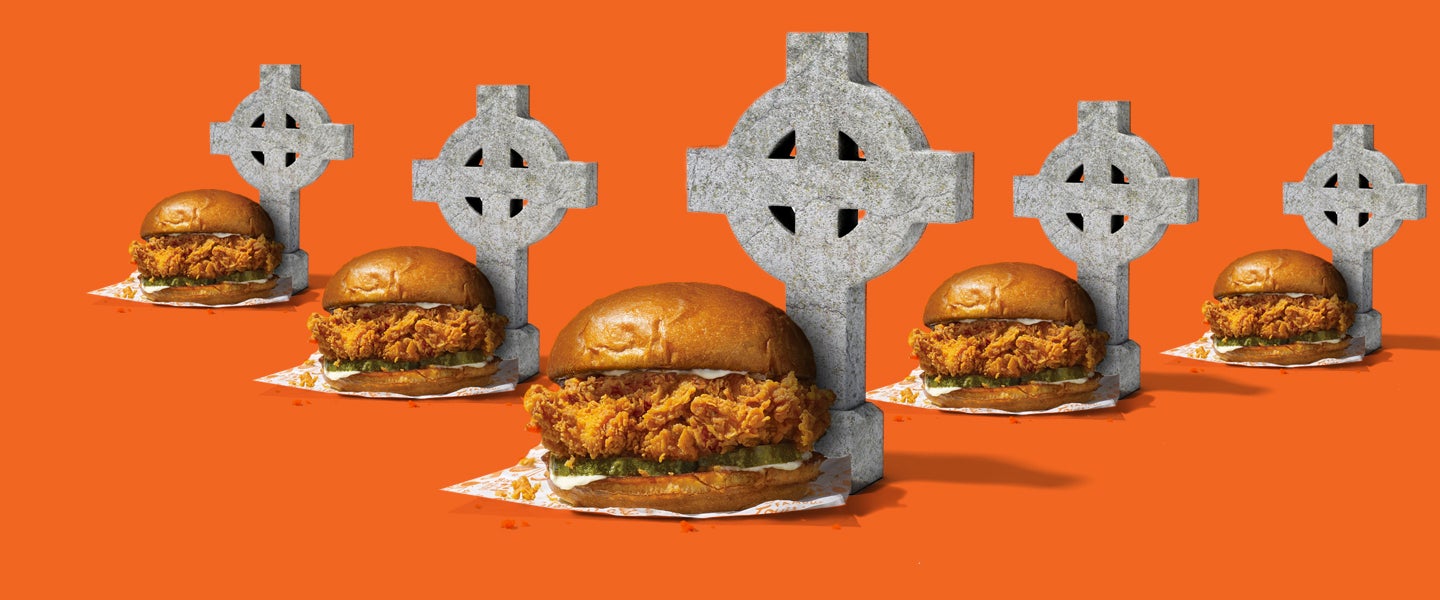“Sorry, we sold out of the chicken sandwiches yesterday,” says the kind, overwhelmed cashier at my local Popeyes. “They’re flying off the shelves.”
I’m disappointed; I’d really love to try one of these fried-chicken sammies my friends can’t stop talking about. The illustrious lunch — “flavorful and juicy, encased in a spiky, golden sea urchin of batter” — was heralded by the New Yorker as “here to save America” and became a digital marketing team’s wet dream as the hype spread around Twitter. Popeyes’ sandwich got so big, it launched an obnoxiously petty social-media spat among fast-food brands.
Lil Yachty spent the entire day trying to get the new Popeyes chicken sandwich ?? pic.twitter.com/tc9gvvhrf3
— Hot Freestyle (@HotFreestyle) August 21, 2019
But the real reason I’m here is to do some greasy, sloppy, Popeyes-napkin math. I’d like to find out how many deboned and -beaked bird corpses lie in the ground below the Great Chicken Sandwich Brand War of 2019. What’s the agricultural impact of a viral chicken sandwich?
Of course, the restaurants went dark when I asked for specific sales numbers, so I chatted with some poultry-industry experts and data scientists to hazard a guess.
Did you know that we slaughter more than 9 billion chickens a year? To be precise, 9,160,910,000 in 2018, according to the USDA. In August 2018 alone, we killed 834,864,000. Per week, the chickens slaughtered for the U.S. food supply numbered about 176,171,000.
According to the National Chicken Council, 25 percent of the poultry supply went to fast food chains in 2010. If that number has remained at 25 percent, that means roughly 44 million chickens were slaughtered per week for U.S. fast food in 2018.
All this contributes to the agriculture industry’s massive carbon footprint — but compared to cattle, the poultry industry has a much smaller impact in terms of methane emissions. Chick-fil-A’s “Eat Mor Chikin” sign isn’t bad advice, at least if you’re used to eating beef.
So what happens when there’s a viral launch like Popeyes’, and the chicken sales spike? Tom Super, senior vice president of communications at the National Chicken Council, says he can’t think of anyone who tracks poultry consumption on a weekly basis. Mark Brandau, the managing editor for Datassential, “the food industry’s leading market research fund,” says he “couldn’t credibly estimate how many chickens died for us today.” But I am nobody and the Quinn Myers name means nothing in the stats world, so why not try?
The Popeyes employee tells me their store orders three cases of the sandwiches every three days, and there are 60 sandwiches in a case. “And we’ve been sold out since Tuesday.”
There are about 3,000 Popeyes locations worldwide, most of which are in the U.S. One site tallies 2,378 American locations. The math depends on how many stores are selling chicken sandwiches at the rate of the three Popeyes in Chicago, so let’s give a conservative 50 percent. That would be 1,189 stores, selling 180 sandwiches every three days, for nine days since the launch.
Assuming 1 sandwich = 1 breast = 1 bird, this puts the dead-chicken toll for Popeyes at a relatively low 640,000 and rising. Yes, low. Even if every single store were selling out, and the sandwich count were closer to 1.3 million, this would comprise a tiny fraction — 0.7 percent — of the 176,171,000 chickens slaughtered weekly in the U.S., about a quarter of which goes to fast food.
But the big takeaway is that high demand for a sandwich doesn’t directly translate into more dead birds. “All of this stuff is worked out in advance,” says Tom Super of the National Chicken Council. “A lot of supply comes from cold storage, previously processed.” So no, your coveted Popeyes chicken sandwich isn’t destroying the planet faster, nor is it sending a flock of new chickens into the death machine. They were likely among the billions already dead.

